The Future of Nature

Foxes in our neighborhoods?
Coyotes on the lawn?
So where have all them rabbits
and stray kitty cats gone?
As my neighbors post their animal sightings on the “Next Door” website—as they swoon, that is, over the “cute” red foxes racing through the front yards of our civilized habitat—I pause to consider. Personally I am grateful those critters keep a safe distance (bless their furry little survival instincts) but can it be long before they come a-begging at my door?
I conclude there will always be a difference of opinion. There are those who are charmed. There are those who are alarmed. No matter, the facts of the case are straightforward. Researchers have confirmed that our cities are becoming the destination for both invasive plant and wild animal species. Look no further than just beyond your mailbox.
And the exemplar? That honor should probably go to the much-talked-about urban coyote that began expanding its range in the early 1900’s. That was back when its fearful predators (mountain lions, wolves, pumas and the like) were hunted into oblivion. And perhaps for that reason, this wiliest of species averted extinction—in fact, managed not so much an escape as a conquest, flourishing where it was never expected to show up, let alone thrive.
Incredibly, this animal can now lay claim to the entirety of North and Central America—to towns and cities and swamps and prairies and all manner of in-between.
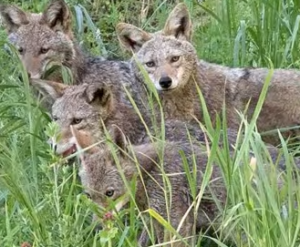
Coyote cubs in the urban wetlands
Even more amazing, the latest research indicates the coyote has pulled off a Harry Houdini: crossing the Panama Canal in 2010. Will it survive the dive? Naturalists in the field are eager to find out, having already placed their “camera traps” in the adjacent southern highlands.
The urban assault comes from all corners of creation: plants, animals, fungi, insects. Is this something entirely new? Scientists have been hot on the case, even if they differ wildly. You have your urban ecologists and your ecomodernists and your compassionate conservationists and your stalwart biologists. And being that they are all homo sapiens like my neighbors, they do not always agree.
Some say cities are the answer to solving the soaring extinction rates. Others dwell in the land of the future, where extinction has already taken its toll and we must make hard decisions. Finally there’s the old school, who see in rich biodiversity and climate control the only hope for a stable environment.
My head wants to learn all I can from each perspective. My heart is with the latter. It seems without any kind of plan to set aside pristine habitat, we could lose not only cherished wilderness, but the nurturing embrace of the earth itself.
Menno Schilthuizen
“Darwin Comes to Town” (2018)
They say get used to it. “Urban” is the future of life on Earth. By 2030, 10 percent of all people will live in megacities. By 2050, 70 percent of all people will live in cities of some kind, and destruction of rain forests and remote habitats will be accelerating.
Planners are beginning to think of this as the new normal. Urban studies are all abloom. Urban Planning, Urban Engineering—and yes, even Urban Ecology.

Menno Schilthuizen
That’s Menno Schilthuizen’s gig. He is a biologist with a gift for scientific tale-telling in the classic style—himself yet another variation of the species we once knew as Stephen J. Gould.
Both a researcher and popularizer of scientific topics over nearly three decades, Schilthuizen has been showing up on the morning shows and in public forums at museums and libraries. His last name, which is Dutch, does not seem to be easily pronounceable by American interviewers. The best I can offer is “shill-tize-in.”
He certainly doesn’t hide his enthusiasm.
I secretly like cities. Not so much the organized, slick, well-oiled parts of them, but rather the grimy, organic fabric of the city, revealed in forgotten corners where the threadbare carpet of culture gives way—the city’s underbelly where the artificial and the natural meet and engage in ecological relations. To my biologist’s eye, the inner city, for all its hustle and bustle and thoroughly unnatural appearance, becomes a constellation of miniature ecosystems.
p. 2
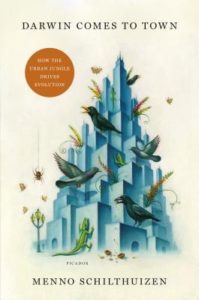 A prime example of such a beast is Culex molestus, a.k.a. the “London Underground mosquito.” That irritating insect first came to prominence as the torturer of Londoners who were sheltering from German bombs at the Liverpool station in 1940. Over the years the mosquitoes took up residence all over England, and the Continent. No one gave it much thought until, in the 1990’s, geneticist Katharine Byrne discovered the little buggers had, in fact, evolved from above-ground mosquitoes.
A prime example of such a beast is Culex molestus, a.k.a. the “London Underground mosquito.” That irritating insect first came to prominence as the torturer of Londoners who were sheltering from German bombs at the Liverpool station in 1940. Over the years the mosquitoes took up residence all over England, and the Continent. No one gave it much thought until, in the 1990’s, geneticist Katharine Byrne discovered the little buggers had, in fact, evolved from above-ground mosquitoes.
Unlike their ancestors, however, Culex molestus never hibernate. They do not breed in swarms, as befits self-respecting mosquitoes. No, instead they breed one-on-one, in tiny pools of seeping water, near blackened brake dust covering shadowy brick walls.
Variations in the species have been recorded among their cousins at different stations. This differentiation is not unlike what Darwin found among finches on the several islands of the Galapagos.
Proteins in its antennae have changed shape so that our human odors, rather than bird smells, elicit a response. Genes that regulate its biological clock have been reset or turned off, to prevent it from going into hibernation, since there is always human blood underground and it never gets very cold. p. 4
It was once thought that evolution takes thousands of years. But it is actually observable in life forms that have extremely short life spans. In fact, proof of evolution has begun to emerge in recent studies tied to the genetics of plants and insects.
Remember the classic tale of mutation in the modern world, that of wing pigmentation in moths in Manchester, England? A story that for a time last century was supposedly “debunked” by creationists?
Well, we now know the process is in fact evolution—caused by the transposition of genes within DNA. A “jumping gene” (technically a “transposon”) is a chromosome able to cut itself out and reinsert itself elsewhere in the DNA strand. Such a trick is done spontaneously in the sperm of the caterpillar, who passes the changed feature along to the moth. It happens randomly, and the resulting characteristic might or might not be a useful thing to have.
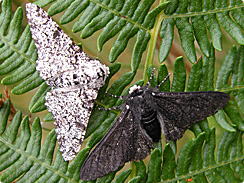
A peppered moth and a black moth
The wing color change from speckled to black first begins as a spontaneous event. Over time, the camouflage feature tended to favor the black moth from its predators like bats and birds—but only against the backdrop of tree bark and leaves blackened by the coal dust in Manchester. Eventually, this resulted in more black moths and fewer speckled (or peppered) moths.
When the black soot became a thing of the past, it happened again, in reverse. Black moths were suddenly more obvious to their prey, and were picked off—and so the advantage shifted to the speckled characteristic. It is not that the moths were trying to do this for their own perpetuation, but rather their numbers were cut or increased by their prey—not by intelligent design, but by random genetic modification.
Cities are now often described as “heat islands” by specialists. Across the globe some of the largest cities are ten degrees warmer than the surrounding topography. In addition to the radiation from concrete and steel, air conditioners alone pump an additional degree of heat into the nighttime atmosphere. Which may account for a new species of leopard frog being found a “stone’s throw from the Statue of Liberty.” (p.51)

A giant apple snail
As cities grow, so also the number of invasive species multiply, largely following in the footsteps of homo sapiens. Singapore, the second busiest port in the world, now boasts a dubious statistic: the sheer quantity of non-native species may soon out-number the native—house crows from India, mynah birds from Java, cow grass and huge apple snails from South America (above)—and many others.
Some of this diversity is believed to be arriving from “dumped aquarium water.” Other invasions occur in the nautical procedures employed by the shipping industry itself.
It is now an established fact that the great cargo ships of our day unintentionally pick up new species when they unload—simply because they take on ballast in their hulls to improve balance—water which is only dumped back into the harbor in their port of call when they [return and] prepare to reload. p. 34
That’s where “supertramp species” come in—plants that can be found everywhere on the face of the planet—now numbering in the hundreds. Fescue, for example, can be spied in grasslands from pole to pole. Similarly the fungus Aureobasidium pullulans—that distinctive orange-colored fungus you find in bathrooms the world over—is continuously supplied by travelers toting their toiletries on every trip.
In the past, most large cities had a natural perimeter founded on land that was once already lush and biologically rich. But that too has changed. Estuaries, flood plains, fertile low-lying areas have been replaced. Where once a small-scale hodgepodge of fields and pastures, hedges and bushes, brooks and ponds was sufficient to keep many animals at bay, the loss of habitat outside of city perimeter has contributed to the invasions we are witnessing, previously unimaginable.
Another reason we now find “brush turkeys in Sydney, coyotes in Chicago, foxes in London, leopards in Mumbai, mugger crocs in Gujarat” may be as simple as survival of the species:
At the present time, coyotes in cities have four times less chance of being killed than in rural areas. p.57
In London, urban enticement is revealed by none other than the stomach contents of a deceased city fox: “rose hips, a small rabbit, an apple, a kebab, and cherries in thick syrup” (p.45).
Other big city attractions to both canine and bird species are the abundance of domestic gardens, ponds, nest boxes, compost heaps. Birds have found soccer fields to be ideal location for building nests lined with colorful nylon strings, feeding their chicks with “fish and chips scraps pilfered from the fish stalls” (p. 42).
Cliff swallows have evolved shorter wings to enable quicker upward flight in their horizontal, skyscraper-heavy environment.
Rural anolis lizards evolved shorter legs and wider toe pads when introduced to a more urban and concrete-laden environment.
Parakeets imported into western Europe since the 1980s have flourished on the streets. The original populations in the tropics have declined, but the urban species—the “inevitable escapees” having flown their cages—are now pounding the pavement for handouts in most European cities.
Road-salting has raised salinity of lakes and freshwater, so that more and more fish are migrating from the seas to seaside ports.
“Urban acoustic” ecologists (a new specialty, I assume) found that birds had adjusted their songs to the noise of the city: a higher pitch, and louder. So have frogs and grasshoppers.
Ornithologists discovered birds in Mexico City that were filling their nests with discarded cigarette butts. Due to the nicotine content, the nests had far fewer mites.
Alas, even the fabled Galapagos has succumbed.
Today’s Galapagos is no longer the deserted pristine place it was when Darwin first set foot there. Over 26,000 people live there, and the islands are visited by hundreds of thousands of tourists every year. … It has an airport, a highway, hotels, football pitches, tour agencies, cafes, and lots of restaurants. p.215
Who, then, might qualify as the most regular patrons of these restaurants? Why, finches of course—the very same species that Darwin studied, and whose images fill his “Voyage of the Beagle” illustrating variants from island to island.
The problem, you see, is these newly-urbanized finches no longer eat much in the way of seeds. Instead, they have evolved a smaller beak size to accommodate their new daily diet—huge helpings of bread, potato chips, ice cream, rice and beans.
ERLE ELLIS
“STOP TRYING TO SAVE THE PLANET” (2009)
This head-scratching, jaw-dropping op-ed published in Wired Magazine hit like a thunderbolt. It brought to the world’s attention a spectacular new futurist movement that essentially turns the biological sciences into a line of business.
We’ve got to stop trying to save the planet. For better or
for worse, nature has long been what we have made it,
and what we will make it.
Ladies and Gentlemen, I introduce you to … an “ecomodernist.”

Erle Ellis
In case you’re wondering, yes, Ellis is a professor. He is an ecologist and also a “postnaturalist.” He is part of a movement, and yes, that movement has intellectual heft. They attract the funding of corporations. They testify before Congress and parliaments the world over. They embrace technology and acceptance of the future. They defend their theses with statistical and ecological studies if not so much in-depth knowledge of biology per se.
Ellis continues:
Nature is gone. It was gone before you were born, before your parents were born, before the pilgrims arrived, before the pyramids were built. You are living on a used planet.
Postnaturalism means loving and embracing our human nature, the nature we have created to feed ourselves, the nature we live in. What good is environmentalism if it makes you depressed about the future?
There is plenty more mileage left in this spaceship Earth. Think about that while enjoying a trip to your local zoo or arboretum — the most biodiverse places that ever existed on Earth.
You get the idea. It is probably best not to over-enshrine Ellis and his colleagues and their over-simplifications. But their numbers are increasing, and the ecomodernist movement is no passing fancy. It is useful to point out that they have their followers … and their sponsors. Simply visit the website of the Breakthrough Institute and in particular read the “Ecomodernist Manifesto.”
If today we still occasionally hear the oxymoron “clean coal” coming out of the mouths of industrialists and politicians, this new breed of university ecologist takes it several steps further, espousing a “new conservation,” accepting our changed world, dispersing proposals for all manner of technological and urban solutions to extinction.
There is Peter M. Kareiva who proposes “working landscapes” to replace wilderness. There is Chris D. Thomas, assuring the world that the extinction of local species will be happily supplanted in kind by invasive species, even noting that mass extinctions were always followed by surges of new life (but of course, neglecting to mention that process takes millions of years).
There is Eileen Crist, not so much defending as promoting our “domesticated planet,” adding “we might put ecological gloom-and-doom to rest and embrace a more positive attitude” about our prospects on this wonderfully humanized world of ours.

Subrat Kumar
And then there is Subrat Kumar, a futurist and biotechnologist, who argues for the benefits of “deextinction”—presumably the ability to restore entire ecosystems (think “Jurassic Park”). Should mankind ever experience any downside or problems, he confidently asserts, “any species we bring back could be engineered to be eliminated easily.” Nice touch.
So what’s not to like about this world of blinders and rose-colored glasses? I know the new science is young, and yet … is not all this eerily reminiscent of those glorious eggheads discovered by Gulliver in his travels, on the flying island in the sky?
At the Grand Academy of Lagado in Balnibarbi, great resources and manpower are employed on researching completely preposterous schemes such as extracting sunbeams from cucumbers, softening marble for use in pillows, learning how to mix paint by smell, and uncovering political conspiracies by examining the excrement of suspicious persons.
— Jonathan Swift, from “Gulliver’s Travels” (1726)
as quoted in Wikipedia
Seriously, though, this is not just an emerging science, it is a call for industrialization over conservation. As we shall see, a counter attack is afoot.
And as you might expect, there is also a political counter attack from “ecosocialists” out there. For the curious I provide this link to the website “Climate and Capitalism”: Another Attack on Anthropocene Science.
Edward O. Wilson
“Half-Earth” (2016)
It was not the “Dawn of Man” but rather the “Great Migrations of Man” from whence once-lowly humanity established a certain dominance. The name for this geological age was, and officially still is, the Holocene. But there has been pressure of late from scientists to either change it altogether, or at least modify the taxonomy of intervening millenia so that our current era can encompass, and account for, the “Age of Man”—a.k.a. the Anthropocene.
In the press and in books and in some scientific literature, that unofficial label has semi-officially become commonplace. The idea is that somewhere along the geologic timeline—when homo sapiens was no longer the lowly hunter-gatherer, when we established agriculture and civilizations—humanity began to seriously impact the environment, and make it serve our needs.
Some would go further. Some would say man has gone too far, and the planet, at best, is nearing early onset … yet another dying off … what they are calling the “Sixth Extinction.”

Edward O. Wilson
Which brings us to the late age of a prolific writer, the naturalist and biologist Edward O. Wilson, who turns 89 this month, and who has over his career penned an impressive edifice of books and articles and films and speeches. Along the way he has sprouted several controversial personas as well. There is the brilliant biologist, the patient researcher, the outspoken scourge of narrow-minded religious ignorance of science—and, without argument, there is the genius-cum-crackpot who at the end of his book “Sociobiology” (1975) postulated that insect colonies should be considered the biological foundation of human society.
Be that as it may, in the past 15 years or so, Wilson has stubbornly grown his popular reputation by championing environmentalism and working tirelessly, as they say, “to save the planet.” Such is his name that people still do listen. His books are entertaining to read, and they sell, no matter the topic. I am pretty sure “Half-Earth” won’t be his swan song on the subject of extinction, but once again he has put up a dogged fight.
A warming world is no joke. It is predicted that a mere 4 degrees C. of warming will result in a “slowly unfolding catastrophe” and in some places we are already approaching half that. Saving the future, ensuring biodiversity (these phrases fly off the page) are incumbent upon us.
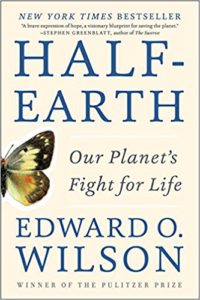 Biologists don’t normally grab our attention. Other than being featured on “nature shows,” they live largely in the shadows, on the underside of life, in the netherworld of ants and fungi and micro mollusks and moth larvae.
Biologists don’t normally grab our attention. Other than being featured on “nature shows,” they live largely in the shadows, on the underside of life, in the netherworld of ants and fungi and micro mollusks and moth larvae.
Their odd perspective is upside-down. Unlike the ecomodernist, the biologist typically starts not with humans, but with unkempt, squiggly miniatures of life itself. They might report on that primordial goo of organisms that work their little flagella off for the well-being of us (our “biome” of microbes). They might document the interrelated, symbiotic web of species-among-species.
Wilson has no quarrel with the “Anthropocene” tag, but saves his venom for the promoters of what he calls “the Good Anthropocene”—the “ecopragmatists” who attract support from fossil fuel industry and “are drawn to geoengineering and solar radiation management as a substitute for reducing emissions.”
Nowhere in the U.S. Wilderness Act do words like “pristine” appear. Surely Kareiva and others of like mind are also aware that the word “wilderness” refers to undomesticated places not yet yoked to the human will. In the parlance of conservation science, “wilderness” means a large area within which natural processes unfold in the absence of deliberate human intervention, where life remains “self-willed.” p. 77
Against this rising tide of reactionary ecology, Wilson launches into passionate defense of accrued knowledge:
Leaders in biodiversity research and conservation have long understood that the surviving wildlands of the world are not art museums. They are not gardens to be arranged and tended for our delectation. They are not recreation centers or harborers of natural resources or sanatoriums or undeveloped sites of business opportunities—of any kind. The wildlands and the bulk of Earth’s biodiversity protected within them are another world from the one humanity is throwing together pell-mell. What do we receive from them? The stabilization of the global environment they provide and their very existence are the gifts they give to us. We are their stewards, not their owners. p.84
Wilson’s primary concern is, succinctly, extinction. One-fifth of known species are now threatened with extinction. In a chapter on why extinction is accelerating, Wilson cites study after study to flesh out his argument that “the Sixth Extinction is underway, and human activity is its driving force.” From these studies, we learn, that it is the rate of extinction that sets us apart from previous geologic times.
Species extinction rates at the present time are one thousand times higher than before the spread of humanity. p.54
If there is a positive side to this, he admits, conservation efforts have effectively reduced extinction rates by about 20%, but even that number differs by species. One ray of light—an independent study in 2006 concluded that extinction of bird species had been cut by about 50 percent.
The five top causes of extinction are hunting, pollution, population growth, invasive species, and destruction of habitat—mostly the result of human activity. Of late, that last item is especially important as rain forests appear to be the next theater in the war on life.
Between 37 and 50 percent of rare tree species in the Brazilian Amazon rain forest … will suffer early extinction, caused by road building, logging, mining and conversion of land to agriculture. p.55
Invasive species – largely a result of man’s conquering of new worlds—bring with them literally the seeds of destruction. Hawaii—now commonly called “the extinction capital of the world”—has a long history of such conquests, beginning with the arrival of Polynesians before 1000 A.D., and resulting in numerous native species being wiped out by the invasions.
It is not exactly intuitive, but extinction itself is an interrelated phenomenon—a “synergistic” process. Put another way, species become endangered as their ecosystems collapse.
The Allegheny woodrat has vanished due to logging and the near, if not final, extinction of the American chestnut tree. Where once woodrats balanced the East Coast ecology, raccoons have taken over, bringing with them a host of roundworms. Okay, evolution may stumble upon a way around the roundworms, but in the meantime we have lost a valuable species, never to return.

The Monarch, the bees and the milkweed
The stately monarch butterfly is the poster child of a species on the brink. It is endangered due to the poisoning of its primary food-giving plant, the milkweed, by glyphosphate, a weed-killer that has wiped out large swaths of the plant. Corn and soybeans flourish in the fields because they were genetically modified to resist the poison—apparently not an option afforded to the lowly milkweed.
Wilson cites stories behind so very many species. The long-leaf pine. Songbirds. Starfish and frogs and tubeworms. And on and on. So many stories, so many ways man has intervened.
In the “aqueous world,” it is well known that currently 19% of coral reefs are dead, and many more dying. What is less well known are the declining numbers of fish themselves.
The assault has been brutal and unrelenting. The numbers of large food and sport species, such as tuna, swordfish, sharks, and larger groundfish (the latter comprising cod, halibut, flounder, red snapper, and skates) have fallen around 90 percent since 1950. Cod, so abundant in the time of the Pilgrims that it was said a meal could be caught with an unbaited hook, have declined by over 99 percent.
p. 67
As we all know, the sea is rising and scarfing up tiny islands the world over, even going after the bigger fish of late: ports and some metropolitan areas in our own country (Norfolk and Miami)—a worldwide event seemingly ignored by the titans of business, perhaps because “political leaders in Washington haven’t begun yet to travel to their offices in gondolas.” (p.66)
Wilson salts his fierce and fact-packed narrative with a few well-deserved sarcasms, but for the most part he sticks to his scientific narrative and cites study after study. He holds forth on scientific standards and statistical threshholds such as the “Net Primary Productivity” of the planet that measures inputs and outputs of precipitation and photosynthesis. If he has any ill will it is reserved for the ecomodernists and “Anthropocene ideologists” and what he believes is their vast ignorance of the intricacy and interdependence of life on earth.
He does not seem attracted to the notion that cities are here to save biodiversity. Of the postnaturalists, he ridicules their “half-wide gardens, alien and new hybrid species, and business-friendly landscapes” as being a result of their ignorance and the “meagerness of the literature they consult … unaware of the content and structure of the ecosystems they recommend be put under siege.” In the Smoky Mountains alone, he writes, there are 18,200 known species, tracked and recorded by researchers and trained volunteers. The “extinguishing of any block of five [species]—for example, nemerteans, mollusks, annelids, tardigrades, and arachnids … would trigger a collapse of the whole.” (p.85)
Wilson proposes a recipe for success. It is, admittedly, crazy and outrageous, but no less urgent than a call for scientific rationality in our day of ecological and technological insanity.
The recipe is his “Half-Earth Project” (also a website): take the existing protected-areas around the globe, add a few wilderness areas that have not been so designated, and protect them from human encroachment. Well, actually, not all human interaction:
The Half-Earth solution does not mean dividing the planet into hemispheric halves or any other large pieces the size of continents or nation-states. Nor does it require changing ownership of any of the pieces, but instead only the stipulation that they be allowed to exist unharmed. … The pieces range in size from the major desert and forest wildernesses to pockets of restored habitats as small as a few hectares.
It does … mean setting aside the largest reserves possible for nature, hence for the millions of other species still alive. p. 189
In its fine print, which covers several chapters, the idea is a lot more sophisticated than what I am able to convey here. But the fundamental principles, he thinks, could create a new start for the future of nature. No question that nature, in the absence of man, would rebound all by itself.
Wilson probably knows that among all the big ideas in the world only a few prosper, and the remainder wither on the vine. And so to his recipe he adds a vigorous seasoning of conservation practices. Greenhouse gases, underground water levels—all the most pressing needs must be attended to as well.
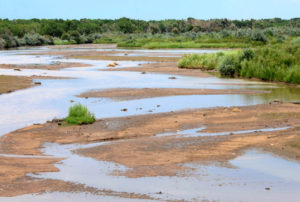
The Rio Grande River in New Mexico
So, of course we must use our technological prowess to address them. If underground water is allowed to go dry, there will be “untold anarchy” in rural India and the Middle East, and a worldwide cascading effect.
On the other hand, why propose an ecomodernist, and ultimately artificial, conservation plan that supports agribusiness when there is a crying need for a new agriculture (i.e. not corn and other thirsty plants) that relies on less water? Why not use our unmatched skills to create solutions?
… as the Colorado River has no more to give to the water-starved fields of America’s Southwest, agriculturists will at last have to turn to dryland crops… species characterized by deep perennial roots, and more drought resistant grasses that bear edible seeds. p.171
Okay, sure, most species don’t, and indeed can’t, live as long as ants and trees (those life forms have been around for ten million years!), but that doesn’t mean that mankind shouldn’t try to work this out.
When we allow just one species to die, we erase the web of relationships … p.106
After all species have gone extinct on the face of the earth—could there be anything left? Has the web of life no beginning?
Well, for Wilson, there is a strange kind of hope. In a brief bookend and somewhat tongue-in-cheek meditation on the “End Times,” Wilson speculates there just might be a chance for intelligent life on Earth to get a rewind.
As is typical of this author, he offers up evidence. With the advent of robotic cameras, he says, stories have emerged of new microbial life at the bottom of the sea. Bacteriophages (literally eaters of bacteria) might be the first link in the chain of life.
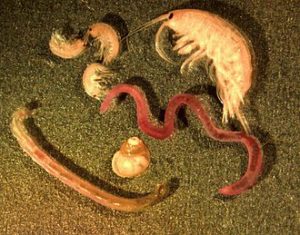
Benthic creatures
And since we have discovered life at the darkest bottom of the ocean (this deep geologic playing field is officially called the abyssal benthos), might we not take solace in the fact that all these strange animals, living near flutes of hot water and consuming sulfates and carbon nitrogen, could conceivably live on? Take, for example, a certain nematode worm that lives many meters below the benthic crust, as it is called, feeding on microbes.
If our species, self-appointed Lords of Earth, accidentally burned the planet’s surface to a crisp, or an outsized asteroid were to wipe out all organisms on the surface, life could go on in the planet’s deep biosphere. There, its microbes and invertebrate predators would persist, shielded and unconcerned in their dark refugia, drawing their energy and substance from rocks, resistant to heat, perhaps evolving over hundreds of millions of years, eventually to reach the surface and generate a diversity of multiple-celled organisms, thence against heavy odds a human-grade metazoan. Whereby the great cosmic cycle might give intelligence on Earth a second chance. p.130
One Response to “The Future of Nature”
Comforting to know that upon destroying our planet, life will flower anew from the bottom of the sea.